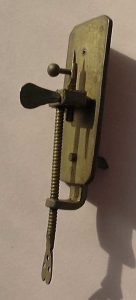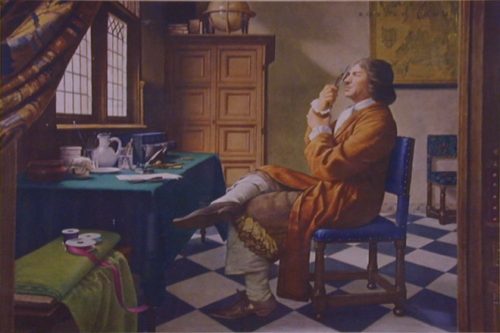This is an impressive microscope. It doesn’t look like much, but this is the kind of instrument Leeuwenhoek used to make his observations, back in the 17th and early 18th century. I did not know until now that it was a mystery how he could magnify specimens 270 times with a simple lens — we didn’t know exactly how he constructed the lens, and he wouldn’t tell anyone. It was his secret, which is not a proper scientific attitude, but OK, it was his key to fame.
Until now, that is. The secret of Leeuwenhoek’s lenses has been cracked! It turns out he borrowed a technique of Robert Hooke’s and improved on it.
But on his most powerful lens, neutron tomography revealed that Van Leeuwenhoek used another technique entirely. It was almost perfectly spherical and completely smooth, without the sharp rim inevitably created by a traditional grinding cup. Even more tellingly, the lens retained the faint remnants of a snapped stem, concealed by the brass plates since the day Van Leeuwenhoek had placed it there.
The stem is a smoking gun. It’s the unavoidable result of forming a lens by melting a thread of glass until a bead forms on its end and then snapping it off. In other words, to make his greatest lens, Van Leeuwenhoek copied Hooke’s simple recipe from the book that likely inspired him. Cocquyt believes this may explain why he was so circumspect when Hooke asked about his methods; he wanted to avoid giving credit to Hooke himself.
Published in Science Advances last year, Cocquyt’s discovery that Van Leeuwenhoek used a well-known technique reveals a deeper truth about the state of microscopy in the 17th century. It suggests that for all the crafting genius required to make his tiny, super-powered lens, Van Leeuwenhoek’s greatest insight may have been that there was something new to see by making one.
I mean, everyone was copying Robert Hooke in the 17th century and then hiding the fact. Hooke was a real genius, and it makes me wonder why no one wanted to credit him for anything. Apparently, he was an unpleasant character, vain and jealous, and that has damaged his legacy. The lesson: be courteous and nice with your peers!




Isn’t that an ongoing problem with peer review?
I’ll just get my coat…
Perhaps Hooke’s greatest problem was encountering another genius as unpleasant as himself—but who had the political power to elevate himself in their rivalry. Sir Isaac Newton didn’t like him and denigrated Hooke quite effectively (even if it’s not true that Newton saw to it that no portraits of Hooke survive).
Hooke’s biggest problem was Hooke.
The guy liked his secrets. It’s like working in a kitchen and having a chef who won’t share his “secret recipe”. All that does is hurt the rest of the kitchen. Hooke’s secretive paranoia, ultimately hurt the entire proto scientific community.
Is this really new information? There is a community of reconstructionists who build working Leeuwenhoek (& other historical) microscopes, and at least since the late 1990’s, this is how we’ve made our lenses. I hand these out as a parting gift to my PhD students, and each and every one’s lens was made in this manner.
Hooke’s Law had to do with metal springs and harmonic oscillators, but it’s the basis of structural engineering design and even quantum field theory. I wonder what it must have been like to have a mind like his in a society dominated by ignorance and superstition. Oh, wait, I’m talking about the Republican Party again.
@anthony#2: IIRC Hooke started this fight by dismissing Newtons work on optics. Later he accused Newton of plagiarizing him on gravity without ever presenting any proof.
The existence of both a Hooke and a Leeuwenhoek confused me from an early age. First off, the names. Like, there’s a regular hook and fancy hook. Sure… I believe you. And Leeuwenhoek’s microscope has just one lens when compound microscopes had already been around for a while. How does that make sense?
Finally, in physics we did Hooke’s law and I’m like “Wait, he’s a spring guy? I thought you said he was a microscope guy.” Cue Vinnie Barbarino. So confused.
Then I went into computer science and the rest is history.
Delete History click
The lesson: be courteous and nice with your peers!
MEGA CHAD VOICE: I HAVE NO PEERS!
Sorry, couldn’t resist.
@9: I’ve long said that the best way to avoid peer pressure is to acknowledge no peers. But it tends to make people cringe when I say that.
Perhaps it would be better to say that I had plenty of peers when I was a kid, but I didn’t give a damn what they thought.
Ray Ceeya–
Leeuwen is Dutch for lion, so it’s Hooke vs Lionhook.
(…hoek means corner…which kinda ruins the wordplay)
Sorry, that was a response to Paul BC, not Ray Ceeya
It would be nice if rampant egotism were a barrier to a successful scientific career.
chrislawson @13, slightly rephrased, it becomes “It would be nice if there were one more barrier to a successful scientific career.”
(Interesting sentiment)
A lot of researchers have anisotropic unpleasantness- they suck up to superiors and kick downwards.
I have felt that Hooke was underestimated ever since reading Lisa Jardine’s (Jacob Bronowski’s daughter) biography and felt that Neil deGrasse Tyson’s Cosmos was too harsh on him.